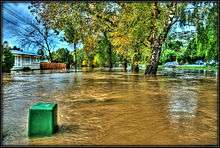Heathcote River
| Heathcote River | |
|---|---|
.jpg) Heathcote River downstream of Barrington Street | |
| Country | New Zealand |
| Basin | |
| River mouth |
Pegasus Bay via the Avon Heathcote Estuary 0 m (0 ft) |
The Heathcote River (Māori: Ōpāwaho) lies within the city boundaries of Christchurch, New Zealand, and is fed from springs near Templetons Road and also receives wet weather flows from as far west as Pound Road. It meanders around the base of the Port Hills from west to south-east.
Course
The catchment of the Heathcote River extends to the suburb of Yaldhurst. It drains an area of approximately 100 square kilometres (39 sq mi), with the Cashmere Stream the largest tributary.[1] It flows through Wigram, Hillmorton (where the main springs are located), Hoon Hay (and from there around the base of the Port Hills), Spreydon, Cracroft, Cashmere, Beckenham, St Martins, Opawa, Woolston and Ferrymead.[2]
It drains into the Avon Heathcote Estuary before draining into Pegasus Bay.[2]
Pre-European settlement and naming

The original name of this river, Ō-pa-waho means 'The Place of the Outward Pā', or 'The Outpost' and refers to this pā being an outpost (Māori: waho) of Kaiapoi.[3] The pā was built in a higher location just downstream of the present Opawa Road Bridge. It was a resting place for Ngāi Tahu travelling between Kaiapoi and Horomaka (Banks Peninsula). The surrounding area was an important mahinga kai, a source of plentiful food, especially tuere (blind eel) and kanakana (lamprey).
The river historically meandered through extensive wetlands prior to urbanisation. Historic survey maps from the mid-19th century (the so-called 'Black Maps') indicate that the habitat that the river passed through was abundant in flax (harakeke), toetoe, raupo, tutu and ferns and was dotted with ti kouka (cabbage tree).

The river corridor was low-lying and very wet. When the Waimakariri River rose and flowed across the plains, even higher ground was prone to flooding. Over many centuries of using the river as a food source and transport corridor, the iwi of Waitaha, Kāti Mamoe and Ngāi Tahu fostered a close relationship with this resource. The swamp forest around the river provided gathering grounds for water fowl and forest birds. Traps were regularly set for inanga (whitebait), pātiki (flounder), and tuna (eel).[4]
The Heathcote River is named after Sir William Heathcote, secretary of the Canterbury Association.[5]
Management

The Heathcote River provided Woolston plentiful water for industries like wool scouring. In 1966 the Woolston industrial sewer was built, and up until that time the river had become increasingly polluted.[6]
Flooding had also become a problem and in 1986 the Woolston Cut began to allow flood waters to bypass a long loop of the river, known as the Woolston Loop. The 510-metre (1,670 ft) long project, which cost NZ$2m, had as a consequence that the trees on the riverbank died as far upstream as the Opawa bridge, and that banks collapsed. Extensive investigations revealed that the trees died from salt water travelling further upstream with every tide (with the salt killing the trees), that the soil structure changed (a sodium / calcium exchange in the clay molecules weakened the soils) and the Tunnelling mud crab had extended its range up the river, further weakening the banks. As a mitigating measure, the Woolston Tidal Barrage was built at the upstream end of the cut, which is only opened in time of floods. During normal flow regimes, the Heathcote remains to flow through the Woolston Loop.[7][8] But despite the Woolston Cut, parts of the Heathcote River flood about annually.
During 2008, Christchurch City Council consulted on a management plan for the section of river located between Colombo Street and Opawa Road, which was formally adopted on 9 April 2009.[2][9]
Notes
- ↑ Management Strategy 1998, p. i.
- 1 2 3 Part1 2009, p. 8.
- ↑ "Ōpāwaho (Heathcote River)". Christchurch City Libraries. Retrieved 22 June 2014.
- ↑ Part2 2009, p. 15.
- ↑ Blain 2007, pp. 41–42.
- ↑ "Story : Canterbury places". Ministry for Culture and Heritage. Retrieved 2 October 2011.
- ↑ "What is the Woolston Tidal Barrage?". Christchurch City Council. Retrieved 2 October 2011.
- ↑ Roper-Lindsay, Judith (1993). "Tales of the Riverbank – Examples of Bank Restoration on Urban Rivers" (PDF). Department of Conservation. Retrieved 2 October 2011.
- ↑ "Mid Heathcote River/Ōpawaho Linear Park Masterplan" (Press release). Christchurch: Christchurch City Council. Scoop. 11 July 2008. Retrieved 22 June 2014.
References
- Blain, Rev. Michael (2007). The Canterbury Association (1848–1852): A Study of Its Members’ Connections (PDF). Christchurch: Project Canterbury. Retrieved 21 March 2013.
- Heathcote River Floodplain Management Strategy (PDF). Canterbury Regional Council, Christchurch City Council. November 1998. ISBN 1-86937-357-X. Retrieved 23 June 2014.
- Mid-Heathcote River/Ōpawaho Linear Park Masterplan. Christchurch, New Zealand: Christchurch City Council. 2009.
- "Part One: The Masterplan" (PDF). Retrieved 22 June 2014.
- "Part Two: Background" (PDF). Retrieved 22 June 2014.
- "Part Three: Key Goals" (PDF). Retrieved 22 June 2014.
External links
| Wikimedia Commons has media related to Heathcote River. |
- Heathcote River walks; pamphlet by Christchurch City Council
Coordinates: 43°33′28″S 172°42′31″E / 43.557700°S 172.708700°E
